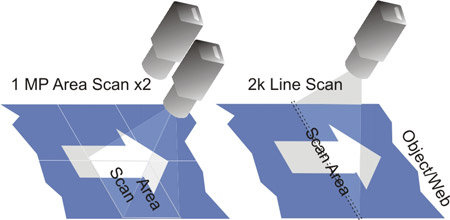Line Scan Primer
Perhaps the most common example of line scan imaging is the fax machine. Line scan imaging uses a single line of sensor pixels (effectively one-dimensional) to build up a two-dimensional image. The second dimension results from the motion of the object being imaged. Two-dimensional images are acquired line by line by successive single-line scans while the object moves (perpendicularly) past the line of pixels in the image sensor.
For a given field of view, one 2k line scan camera cost-effectively provides the same resolution as two mega-pixel area scan cameras, without image smear or the redundant processing of frame overlaps.

Advantages
Advantages Line scan image capture has many benefits, including:
- Price/pixel: line scan offers much more cost-effective implementations of very high spatial resolution image capture
- Dynamic range that can be much higher than alternative image capture methods
- High pixel fill-factor (typically 100%) to maximize sensitivity
- Smear-free images of fast moving objects without expensive strobing or cumbersome shuttering
- Processing efficiency: line scanning eliminates the frame overlaps required to build a seamless image. Frame overlaps represent redundant data that uses up precious processing bandwidth, particularly in high-speed, high-resolution applications.
Tradeoffs
The tradeoffs in line scan imaging usually relate to lighting and optics. Illumination must remain reasonably uniform over the entire field of view, although the in-camera flat-field correction available on almost all of our cameras can compensate for poor uniformity. Integration times in line scan imaging are typically very short, so illumination intensity generally needs to be high--again, Teledyne DALSA's high sensitivity TDI line scan products, with 100x greater sensitivity than most comparable linescan, address this problem. Optical demands center around the typically large image circle diameter required for linescan imagers because of their high resolution, and the minor aberrations inherent in spherical optics.